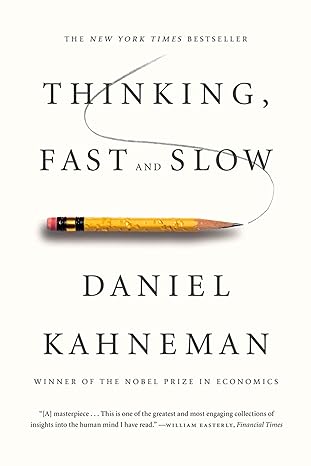Main Topic
“Thinking, Fast and Slow” by Daniel Kahneman explores the two modes of thinking that drive human decision-making: System 1 (fast, intuitive, and automatic) and System 2 (slow, deliberate, and analytical). The book delves into the biases and heuristics that affect our judgment and decision-making processes.
Key Ideas or Arguments
- Two Systems of Thinking: Kahneman introduces System 1 and System 2 thinking, explaining their characteristics and how they interact in our daily lives.
- Anchoring Effect: He discusses how people tend to rely on initial information (anchors) when making decisions.
- Loss Aversion: The book highlights the idea that people are more averse to losing what they have than they are motivated by equivalent gains.
- Prospect Theory: Kahneman introduces the concept of how individuals evaluate potential gains and losses, often irrationally.
- Availability Heuristic: The book explores how people assess the likelihood of events based on their availability in memory.
- Overconfidence: Kahneman discusses how people tend to overestimate their own abilities and knowledge.
- Happiness vs. Experiencing Self: He distinguishes between the two ways people evaluate their lives—evaluative happiness and the moment-to-moment experiencing self.
Chapter Titles or Main Sections
- Prospect Theory: Kahneman introduces the concept of prospect theory, explaining how people evaluate potential gains and losses, often making irrational decisions.
- Heuristics and Biases: This section delves into the various cognitive biases and mental shortcuts that affect our thinking processes.
- Overconfidence: The author discusses the tendency for people to overestimate their own abilities and knowledge, leading to flawed judgments.
- Choices: Kahneman explores how people make choices, emphasizing the impact of framing and loss aversion on decision-making.
- Two Selves: This chapter discusses the difference between the experiencing self and the remembering self, and how it influences our perception of happiness.
- Prospects and Reality: The book delves into how people predict future emotions and make decisions based on those predictions.
- Endings: Kahneman explores the influence of endings and the peak-end rule on our overall evaluation of experiences.
Key Takeaways
- The book emphasizes the role of cognitive biases and heuristics in decision-making.
- Understanding the interplay between System 1 and System 2 thinking can help individuals make better choices.
- Loss aversion and anchoring can significantly impact financial decisions.
- Our assessment of happiness is complex and can be influenced by the way experiences are framed and concluded.
Author’s Background and Qualifications
Daniel Kahneman is a Nobel laureate in economics and a renowned psychologist known for his groundbreaking work in the field of behavioral economics. He has dedicated his career to studying human judgment and decision-making, making him well-qualified to write on this topic.
Comparison to Other Books
“Thinking, Fast and Slow” stands out as a seminal work in the field of behavioral economics and cognitive psychology. It provides a comprehensive overview of the topic and is often compared to works by other notable authors such as Richard Thaler and Cass Sunstein’s “Nudge” and Malcolm Gladwell’s “Blink.”
Target Audience
This book is suitable for a wide range of readers interested in psychology, decision-making, and human behavior. It is accessible to both experts in the field and general readers seeking a deeper understanding of why we make the choices we do.
Reception or Critical Response
“Thinking, Fast and Slow” received widespread acclaim and has been praised for its depth and clarity. It has been lauded as a must-read for anyone interested in psychology, economics, and decision science.
Publisher and First Published Date
Publisher: Farrar, Straus and Giroux First Published Date: October 25, 2011
Recommendations
- “Nudge” by Richard Thaler and Cass Sunstein
- “Blink” by Malcolm Gladwell
- “Predictably Irrational” by Dan Ariely
- “The Power of Habit” by Charles Duhigg
Biggest Takeaway
Understanding the distinction between fast, intuitive thinking (System 1) and slow, analytical thinking (System 2) is crucial for making informed decisions and comprehending the biases that influence our choices.



